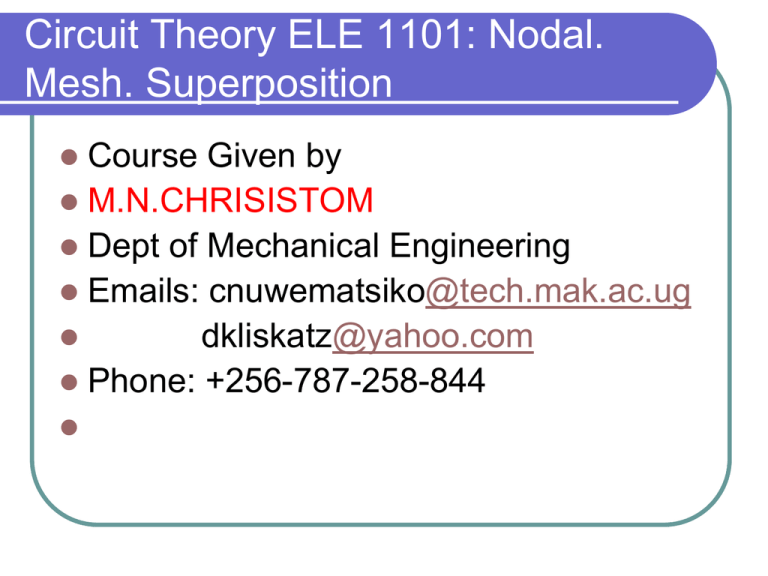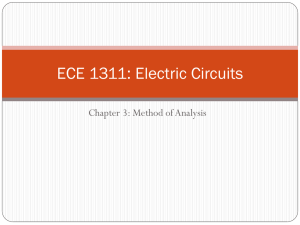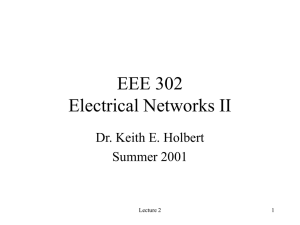Circuit Theory ELE 1101: Nodal. Mesh. Superposition
advertisement

Circuit Theory ELE 1101: Nodal. Mesh. Superposition Course Given by M.N.CHRISISTOM Dept of Mechanical Engineering Emails: cnuwematsiko@tech.mak.ac.ug dkliskatz@yahoo.com Phone: +256-787-258-844 Nodal & Mesh Analyses Nodal Analysis employs KCL & Ohm’s Law so as to determine the currents flowing through resistors (and other requirements). Mesh Analysis employs KVL so as to determine the currents flowing through resistors (and other requirements). Nodal Analysis Step 1: Determine the earth node (whose voltage is zero). Step 2: Determine & number the other nodes. Give @ node a voltage value e.g. v1, v2,.. Step 3: Where there are voltage sources; determine some node voltages by inspection. Nodal Analysis (cont.) Step 4: Use KCL to write down equations for the remaining nodes & solve them simultaneously. Step 5: Complete the solutions required. Nodal Analysis Use Nodal Analysis to find current through R 1 15 4 2 R Nodal Analysis Steps 1 & 2 v i1 1 15 0 i2 i3 4 2 R Nodal Analysis Step 3: is not applicable here. Steps 4&5: solve for v & iR 15 i1 i2 i3 0 Use v to det er min e i1 , i2 , i3 v v v 15 0 1 4 2 60 60 4v v 2v 0 v 8.6V 7 v 30 iR i3 4 .3 A R 7 Nodal Analysis Nodal analysis to obtain i, PR 1 + i 4 2 R 10 15 - Nodal Analysis Steps 1,2 & 3: identify all node voltages. v1 v 1 + i 2 4 R 10 15 - By inspection; v1=15 0 Nodal Analysis Determine v & solve completely Apply KCL at node of v : v v1 v v 10 0 1 4 2 but v1 15; by inspection ; v 15 v v 10 0 1 4 2 100 4v 60 v 2v 40 0 v 7 v 50 i 7.1A PR i 2 R 102.0W R 7 Nodal Analysis: 4 nodes Use Nodal Analysis; find 2 + 97 - iR 6 1 4 R 3 Nodal Analysis: 4 nodes Steps 1,2 & 3: identify all node voltages. 2 1 3 2 + 97 - 6 1 4 0 R 3 Nodal Analysis: 4 nodes Determine v3 & solve completely v1 97;by inspection Apply KCL at node 2 & 3 : v2 v1 v2 v3 v2 0.....[Node 2] 2 6 4 v3 v2 v3 v3 0............[Node 3] 6 1 3 11v2 2v3 582 9v3 v2 0 v3 6 iR 6 2A 3 Mesh Analysis Step 1: Determine & give current values to @ mesh. Step 2: Where there are current sources; determine some mesh currents by inspection. Step 3: Use KVL to write the other mesh equations & solve them simultaneously. Mesh Analysis (cont.) Step 4: Determine the resultant current through @ resistor. Step 5: Complete the solutions as required. Q1: Mesh Analysis Use Mesh Analysis to find current through R (4-ohm resistor) 1 15 4 R 2 Q.1: Mesh Analysis 1 15 mesh 1 4 mesh 2 44 2 mesh 3 Q.1: Mesh Analysis Steps 1,2,3,4 By inspection : i1 15 Apply KVL to the other 2 meshes : mesh 2; 1(i2 i1 ) 4(i2 i3 ) 0 i2 15 4i2 4i3 0 5i2 4i3 15 mesh 3; 4(i3 i2 ) 2i3 0 3i3 2i2 0 45 30 15 i2 , i3 iR i2 i3 7 7 7 Q.2:Mesh Analysis Use Mesh Analysis to find i & PR 2 i 1 4 + R 10 15 - Q.2 Mesh Analysis 2 1 4 + 15 mesh mesh mesh 10 1 2 3 - Q.2: Mesh Analysis Steps 1,2,3,4 By inspection : i1 15 Apply KVL to the other 2 meshes : mesh 2; 1(i2 i1 ) 4(i2 i3 ) 0 i2 15 4i2 4i3 0 5i2 4i3 15 mesh 3; 4(i3 i2 ) 2i3 10 0 3i3 2i2 5 25 5 20 i2 , i3 iR i2 i3 , PR 32.7W 7 7 7 Principle of Superposition “The response of a linear circuit, acted upon by several independent sources, is the algebraic sum of the responses when each source acts alone”. The Principle is useful either in analyses where it is difficult to use the above methods easily or when the individual effects of sources are needed. Exercise on Superposition In the circuits Q1,Q2 & Q3 use any method to determine the current through R. Superposition : Q1 Use Superposition to find i & PR 2 i 1 4 + R 10 15 - Superposition : Q1 Step 1: Let current source act alone: Find i1 Nodal analysis: 2 v1 i1 1 4 R 15 0 Superposition : Q1 Step 2: Let the voltage source act alone: Find i2 by Nodal Analysis 2 v2 i2 1 4 + R 10 - 0 By Nodal Analysis: v1 v1 v1 60 v1 15 15 0 v1 i1 1 4 2 7 4 7 v2 v2 v2 10 20 v2 5 0 v2 i2 1 4 2 7 4 7 By Superposit ion. Pr inciple 20 1600 2 i i1 i2 PR i R 32.7W 7 49 Superposition : Q2 Use Superposition to find i & PR 1 i 6 + 27 - R 3 4 2 15 Superposition : Q2 Step 1: Let voltage source act alone. Use Nodal Analysis to find iR1 v1 v 1 iR1 6 + 27 - 4 3 0 2 Superposition : Q2 Use Nodal analysis: By inspection ; v1 27 By nodal analysis ; v v1 v v v v 0 1 6 3 4 2 12(v 27) 2v 4v 3v 6v 0 v 12 v 12 iR1 4A R 3 Superposition : Q2 Step 2: Let current source act alone. Use Nodal Analysis to find iR 2 v2 1 iR 2 6 R 4 3 2 15 0 Superposition : Q2 Use Nodal analysis: v2 v2 v2 v2 v2 15 0 1 6 3 4 2 20 20 v2 iR 2 2.2 A 3 9 By Superposit ion Pr inciple; 20 iR iR1 iR 2 4 6.2 A 9 2 PR iR R 116.1W Q3: Superposition By Superposition Principle find PR 4 2 + R 10 - 3 12 Q3: Superposition Step 1: Let current source act alone 4 2 i1 R By current division: i1 = 24/5= 4.8A 3 12 Q3: Superposition Step 2: let voltage source act alone 2 4 i2 + R 10 - Apply KVL: i2 = 10/(2+3) = 2A 3 Q3: Superposition Apply Superposition Principle iR i1 i2 4.8 2 6.8 A 2 PR iR R 138.72W Note; PR PR1 PR 2 i1 R i2 R 2 2 69.12 12 81.12W [ Because of i 2 power is not linear ] Q4: Superposition Use the Superposition Principle to determine the current in R. 3 + 26 - 4 39 R 2 13 Q4: Superposition Let @ source act alone. Nodal Analysis: Voltage source alone : v1 26 v1 v1 0 v1 8 i1 2 3 4 2 39 A current source alone : v2 v2 v2 39 0 v2 36 i2 9 3 4 2 13 A current source alone : v3 v3 v3 13 0 v3 12 i3 3 3 4 2 i i1 i2 i3 2 9 3 4 4 A upwards .





